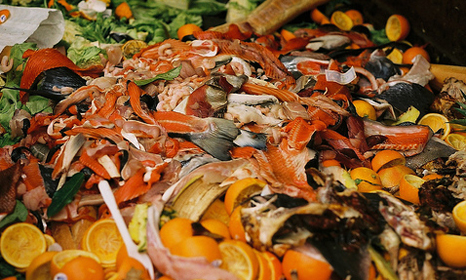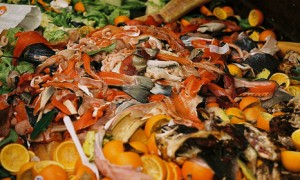We humans are careless with food. Every year as much as a third of what we produce goes to waste. So says the FAO, the Food and Agriculture Organization of the United Nations. In fact global food waste is estimated at 1.6 Gigatons (a gigaton is a billion tons) with total agricultural production equivalent to 6 Gigatons every year.
Another frightening statistic is the estimate of land that we humans tie up to produce all of this uneaten production – 1.4 billion hectares (almost 3.5 billion acres), equal to about 28% of the world’s agricultural lands. Compare that area to Canada (the second largest country in the world) at 1 billion hectares in total land mass and you can see just how big the geographic impact is on total land mass on our planet.
Additional planetary impacts. Wasted food produces greenhouse gases estimated at 3.3 Gigatons of carbon dioxide per year. Only the United States and China produce greater carbon emissions.
Finally all of this wasted production consumes lots of water an increasingly scarce resource. The total volume equals the annual flow of the Volga, Europe’s largest river, about 250 cubic kilometers of freshwater.
With between 800 million and 1 billion humans experiencing hunger on the planet it would seem that one immediate solution would be to reduce the amount of food we waste. It would mean less pressure on land and freshwater usage.
The FAO study breaks down wastage from cereals, pulses (peas, beans, etc.), fruits, vegetables, root crops, meat and dairy, fisheries and aquaculture. The study also compares food wastage to carbon footprint by different regions with industrialized Asia, and South and Southeast Asia leading while North Africa, Western and Central Asia, North America and Oceania contributing the least in both categories.
Common characteristics across all regions include:
- Pulses, fisheries and aquaculture contribute the least in waste and carbon footprint (1 to 6%).
- Starchy roots contribute the second least (7%) across all regions with Sub-Saharan Africa (24%) the exception.
- In all regions cereals, meat and vegetables are the greatest carbon contributors.
- Cereal wastage in Asia has a major impact on carbon and freshwater resources.
- Although meat has the highest carbon footprint it has the lowest wastage by volume.
The global carbon footprint from food wastage amounts to average of 500 kilograms (1,100 pounds) of carbon dioxide per person with Europe, North America, Oceania and industrial Asia averaging 700 to 900 kilograms (1,540 to 2,160 pounds), while Sub-Saharan Africa produces 180 kilograms (396 pounds).
With agriculture accounting for 92% of human water usage, the FAO study shows that India, China and Pakistan are the biggest consumers in relation to water consumption correlated to food wastage. The biggest wasters of water of course are animals followed by cereals and fruit crops, while starchy roots contribute the smallest footprint.
In terms of regional water use correlated to food wastage North America, West and Central Asia, and South and Southeast Asia share the largest footprint largely because of cereal production. Sub-Saharan Africa on the other hand uses the least. In terms of per capita results the largest freshwater footprint correlated to food wastage belongs to North Africa, and Western and Central Asia.
Comparing regional food wastage and surface water availability gives you an indicator of the ineffectiveness of agricultural performance within a region. When looking at data this way industrial Asia, South and Southeast Asia are least efficient.
Besides the nutritive value lost by food wastage we also must consider the economic impact. The FAO study estimates the cost based on 2009 producer prices at $750 billion U.S. annually. That is equivalent to the gross domestic product of Turkey based on 2011 data.
This FAO study is the first of its kind and should help identify ways to track wastage so that tools and strategies can be developed to mitigate food losses. In correlating carbon footprint and water usage to food wastage the study is providing a means by which countries can institute new agricultural policies to develop sustainable agricultural practices. And finally, although the study attempts to look at food wastage and biodiversity, this appears to be the weakest area of analysis. The authors readily admit they need better tools to address biodiversity and food wastage within the cycles of production, processing, distribution and consumption. The environmental cost of lost natural resources from food wastage have yet to be taken into account.










